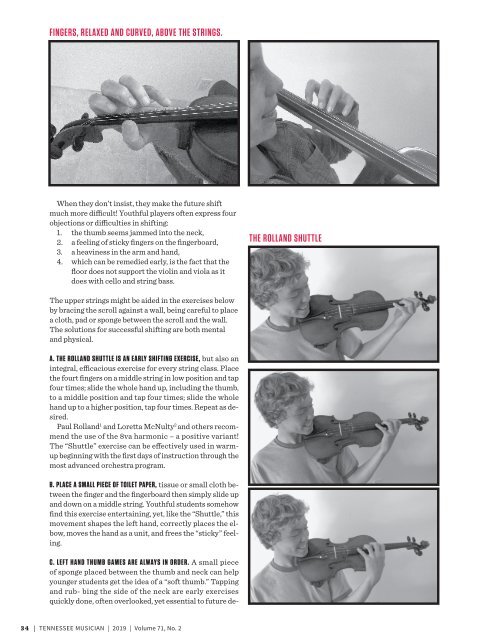TN Musician Vol. 71 No. 2
Create successful ePaper yourself
Turn your PDF publications into a flip-book with our unique Google optimized e-Paper software.
FINGERS, RELAXED AND CURVED, ABOVE THE STRINGS.<br />
When they don’t insist, they make the future shift<br />
much more difficult! Youthful players often express four<br />
objections or difficulties in shifting:<br />
1. the thumb seems jammed into the neck,<br />
2. a feeling of sticky fingers on the fingerboard,<br />
3. a heaviness in the arm and hand,<br />
4. which can be remedied early, is the fact that the<br />
floor does not support the violin and viola as it<br />
does with cello and string bass.<br />
THE ROLLAND SHUTTLE<br />
The upper strings might be aided in the exercises below<br />
by bracing the scroll against a wall, being careful to place<br />
a cloth, pad or sponge between the scroll and the wall.<br />
The solutions for successful shifting are both mental<br />
and physical.<br />
A. THE ROLLAND SHUTTLE IS AN EARLY SHIFTING EXERCISE, but also an<br />
integral, efficacious exercise for every string class. Place<br />
the fourt fingers on a middle string in low position and tap<br />
four times; slide the whole hand up, including the thumb,<br />
to a middle position and tap four times; slide the whole<br />
hand up to a higher position, tap four times. Repeat as desired.<br />
Paul Rolland 1 and Loretta McNulty 2 and others recommend<br />
the use of the 8va harmonic – a positive variant!<br />
The “Shuttle” exercise can be effectively used in warmup<br />
beginning with the first days of instruction through the<br />
most advanced orchestra program.<br />
B. PLACE A SMALL PIECE OF TOILET PAPER, tissue or small cloth between<br />
the finger and the fingerboard then simply slide up<br />
and down on a middle string. Youthful students somehow<br />
find this exercise entertaining, yet, like the “Shuttle,” this<br />
movement shapes the left hand, correctly places the elbow,<br />
moves the hand as a unit, and frees the “sticky” feeling.<br />
C. LEFT HAND THUMB GAMES ARE ALWAYS IN ORDER. A small piece<br />
of sponge placed between the thumb and neck can help<br />
younger students get the idea of a “soft thumb.” Tapping<br />
and rub- bing the side of the neck are early exercises<br />
quickly done, often overlooked, yet essential to future de-<br />
34 | TENNESSEE MUSICIAN | 2019 | <strong>Vol</strong>ume <strong>71</strong>, <strong>No</strong>. 2

















